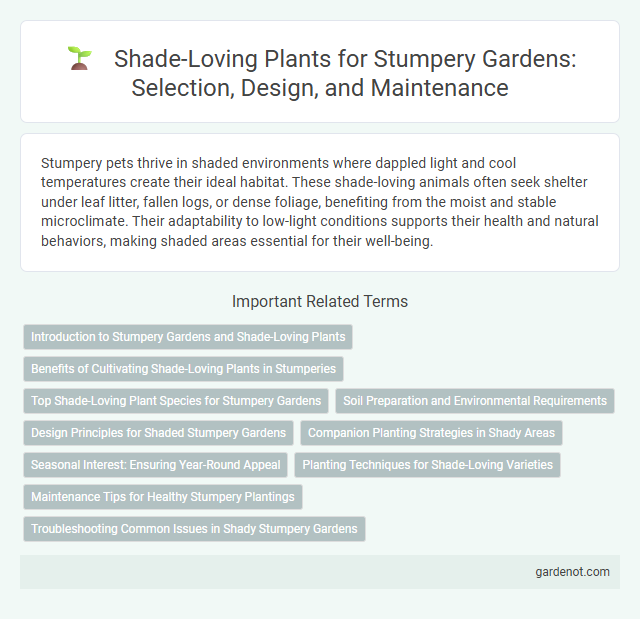Stumpery pets thrive in shaded environments where dappled light and cool temperatures create their ideal habitat. These shade-loving animals often seek shelter under leaf litter, fallen logs, or dense foliage, benefiting from the moist and stable microclimate. Their adaptability to low-light conditions supports their health and natural behaviors, making shaded areas essential for their well-being.
Introduction to Stumpery Gardens and Shade-Loving Plants
Stumpery gardens showcase artistic arrangements of decaying wood combined with shade-loving plants such as ferns, hostas, and hellebores that thrive under low-light conditions. These unique gardens create a cool, moist environment ideal for mosses and shade-tolerant groundcovers, enhancing biodiversity and adding texture to shaded landscapes. Stumperies blend natural decay with botanical beauty, making them a sustainable option for shade garden design.
Benefits of Cultivating Shade-Loving Plants in Stumperies
Cultivating shade-loving plants in stumperies enhances biodiversity by providing a habitat for ferns, mosses, and hostas that thrive in low-light conditions. These plants improve soil health through moisture retention and nutrient cycling, contributing to a resilient garden ecosystem. Shade-tolerant species also reduce maintenance needs by resisting drought and minimizing weed growth, ensuring sustainable greenery in shaded garden areas.
Top Shade-Loving Plant Species for Stumpery Gardens
Top shade-loving plant species for stumpery gardens include ferns like Dryopteris erythrosora and Athyrium niponicum, which thrive in low light and provide lush, textured foliage. Hostas, particularly 'Blue Angel' and 'Sum and Substance', offer broad leaves that complement the rugged wood structures typical of stumperies. Woodland wildflowers such as Trillium and Cyclamen coum add seasonal color while adapting well to the damp, shaded environment beneath fallen logs and stumps.
Soil Preparation and Environmental Requirements
Shade-loving plants in a stumpery thrive best in well-drained, humus-rich soil that retains moisture without becoming waterlogged. Ideal soil pH ranges from slightly acidic to neutral, supporting moisture-loving ferns, hostas, and shade-tolerant shrubs. Consistent shade, protection from harsh winds, and adequate humidity create optimal microenvironments for these plants to flourish in stumperies.
Design Principles for Shaded Stumpery Gardens
Design principles for shaded stumpery gardens emphasize selecting shade-tolerant plants such as ferns, hostas, and mosses to create lush, textured layers around decaying wood structures. Incorporating a mix of native species enhances biodiversity and ensures ecological harmony within the woodland environment. Strategic placement of stumps and logs maximizes dappled light exposure while maintaining moisture levels essential for plant health and fungal growth.
Companion Planting Strategies in Shady Areas
Shade-loving plants such as ferns, hostas, and astilbes thrive in stumpery gardens by benefiting from companion planting strategies that optimize low-light conditions. Pairing moisture-loving species like Solomon's seal with drought-tolerant shade plants enhances soil health and reduces pest risks. Strategic layering of ground covers beneath taller shade-tolerant shrubs creates microhabitats that improve nutrient cycling and support biodiversity in shady environments.
Seasonal Interest: Ensuring Year-Round Appeal
Shade lovers like ferns and hostas offer diverse textures and rich foliage colors that enhance seasonal interest in stumperies. Incorporating evergreen plants such as hellebores and evergreen ferns ensures vibrant greenery during winter months. Deciduous shade plants with striking autumn hues, including Japanese maples, provide continuous visual appeal throughout the year.
Planting Techniques for Shade-Loving Varieties
Shade-loving plants thrive in stumpery gardens by using planting techniques such as layering soil with organic mulch to retain moisture and maintain cool root zones. Selecting varieties like ferns, hostas, and hellebores that adapt well to low light enhances growth and vibrancy. Proper spacing ensures airflow, preventing fungal diseases common in shaded environments.
Maintenance Tips for Healthy Stumpery Plantings
Shade-loving plants in stumperies thrive with consistent moisture and well-drained soil to prevent root rot. Applying organic mulch helps retain soil moisture and suppress weeds, creating an ideal environment for ferns, hostas, and woodland groundcovers. Regularly removing dead foliage and monitoring for pests like slugs ensures vibrant, healthy plantings in shaded garden areas.
Troubleshooting Common Issues in Shady Stumpery Gardens
Shady stumpery gardens often face challenges such as poor drainage, moss overgrowth, and insufficient air circulation. Ensuring soil remains well-drained by incorporating organic matter prevents root rot and supports healthy plant growth. Regularly pruning surrounding foliage and selecting shade-tolerant plants like ferns and hostas enhances airflow and reduces fungal diseases in shade lover stumperies.
Shade lover Infographic

 gardenot.com
gardenot.com